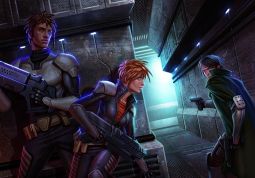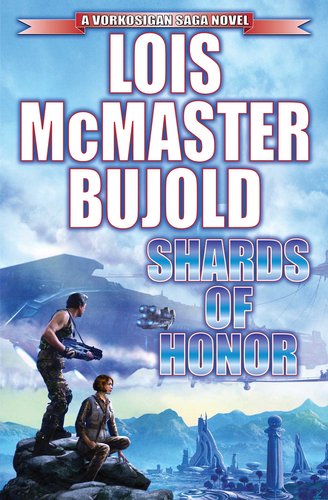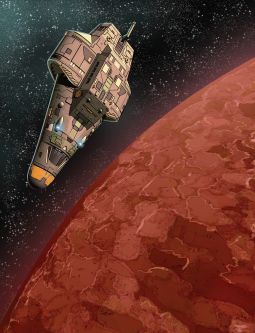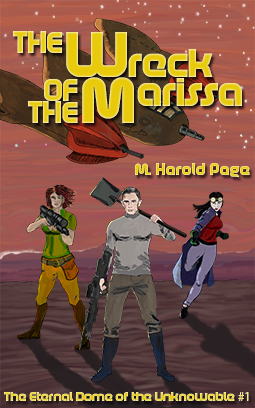Worldbuilding a “Star Punk” Future

You know the genre I mean. It’s the one that takes in Firefly, Dumarest… it’s Space Opera’s Sword & Sorcery. It’s Han Solo: The Early Years or Indiana Jones does Hitchhikers Guide to the Galaxy, or Almost Any Clint Eastwood Movie Ever But In Space. It’s what Traveller RPG supports in all its incarnations.
It doesn’t have a name, so I’ve taken to calling it “Star Punk.” Here’s how I tried to define it in my guest post for uber SF meister Charles Stross:
They are all set in spacefaring civilizations where technology has somehow — with an authorial handwave — and my handwave is particularly cunning and internally consistent — failed to eliminate the human element, where you still need a human to pull the trigger or pilot the scout ship, and where nanotechnology, 3D-printing and vertical farms have neither eliminated trade, nor ushered in a crime-free post scarcity society. They all involve individuals or companions — adventurers, traders, investigators, contractors — pursuing goals of only local significance.
In other words, they could all be transcripts of particularly good Traveller campaigns.
Writing Star Punk, as I discovered when I started planning The Wreck of the Marissa, poses certain worldbuilding problems. (And, yes in this case, I really mean “universe building” but worldbuilding now has a specific technical meaning for writers and other creatives.)
The issue is this bit: where you still need a human to pull the trigger or pilot the scout ship, and where nanotechnology, 3D-printing and vertical farms have neither eliminated trade, nor ushered in a crime-free post scarcity society.
In a nutshell, any realistic starfaring future is unlikely to be like this. In fact, our technology is already breaking the Star Punk future.

Let me just list some established or emerging technology that are already breaking the tropes before we’ve even established our first offworld colony: DNA testing, criminal databases, and facial recognition (BEEEEPPP! “Sorry Mr Solo, step this way please…”); 3D printing and nanotechnology (“Why are you trying to sell me an imported land speeder, my grandpa normally prints mine?”); personal Heads Up Displays and targeting computers (“It looks like you’re entering a firefight. Would you like Windows for Implants(tm) to kill everybody in the room or just the people in enemy uniform?“); attack drones (“Go home, flyboy, you can’t take the Gs.”), nano-tech weapons (Han Solo gets dissolved first); vertical farms, hydroponics and cold fusion (“What’s ‘economics’, Daddy?”)
And so on.
OK. I can sense you’re itching to jump in and say, “Ah but, even in our world, the future is imperfectly distributed. There’ll always — plausibly — be a lower-tech frontier worlds where the adventure happens. Or perhaps there are lost colonies.”
This is the solution adopted by, e.g., Bujold, Banks and Asher, and the one systematised by the Traveller roleplaying game’s tech level system(*). The game Diaspora even takes this further: all really high tech worlds are collapsing by default — e.g. vanishing into an upload indistinguishable from mass extinction, or on the verge of devolving into grey goo.
I’m certainly happy to suspend disbelief for these. However, I am not sure their story worlds bear too much scrutiny.
The snag is that, though modern technology as a whole is imperfectly distributed, its robust or vital (usually “vital” as in “vital for killing other people”) subsets are very thoroughly distributed. Thus you’ll find remote Amazon tribes wearing T-shirts, sword-wielding hill warriors brandishing RPGs and AK47s, mobile phones so ubiquitous in Africa that the landline infrastructure will never be fully developed, and repair shops for mobile phones springing up all over the third world (*). Meanwhile, governments buy missile systems and secondhand AFVs, and deploy modern IT to beef up their under-resourced bureaucracy… the one that will keep track of the Han Solos and Dumarests of our world.
A starfaring future where space travel is routine and starships are as ubiquitous as tramp steamers and don’t require NASA-level ground-side support, implies a lot of very robust technology, most of it easily portable and some, surely, self-replicating.
Frontier worlds, for example, are not going to look very frontier like. The settlers’ dwellings will be grown from nanotech — or biotech! — seeds. Drones will keep away the local hostile fauna and monitor law and order. Automated robots will extract minerals. 3D printers will spit out technology or clothes as required. The colonists may farm, but are just as likely to sit back and rely on the hydroponics and meat growing vats. Really, their only motivation for settling on a new world is the desire for an open sky rather than an orbital habitat.

The irony then, is that in order to write this kind space adventure — Star Punk — you need to find ways not of extrapolating technology, but of limiting it!
There are several proven approaches to this.
First, just ignore the problem.
This works better for media SF — Star Wars! — than in print, but it still works because the reader wants a particular kind of story and is happy to accept the setting’s technology as a “gimme” — this is one reason why I think this genre really is a -punk. You are, however, advised to stay clear of spotlighting innovative engineers and designers. Once one person has strapped a blaster to a droid, then the killer robot is out of the bottle.
Second, use culture to sit on the bits of tech that would break your setting.

The most obvious examples are in the parent Space Opera genre: in Weber’s Honor Harrington books, the Solarian League will trash your civilisation if you start destroying habitable worlds; in Dune, various castes control key technologies; and in the Praxis books of Walter Jon Williams, batshit crazy ancient aliens have enforced cultural taboos on technology such that space navies look awfully 1940s. Many settings are like the Warhammer 40K universe, where much of the technology is conveniently lost, and the rest is caste-bound.
Third, use the technology to limit itself. This usually manifests in items such as Dune’s personal shields which force people to fight hand-to-hand. However, when I picked this option, I did something different.
In the Shard Universe, setting for my Eternal Dome series, the shard technology that supports interstellar travel breaks the microlectronics.
My shards are exotic crystals formed by the collision of another universe with ours. Their precise form depends on the matrix of mundane matter. For example, iron rich locations yield different shards from, say, silicon rich ones, and shard deposits are rare enough that it’s worth fighting a war over an asteroid belt, rather than simply moving onto the next system.
Wire up the right kind of shard, and you can have anything from a life force projector, through a blaster, to an FTL drive. You can even have an AI, but that and other more refined uses are artisan products, requiring the shard to be hand tuned, and possibly hand taught. Yes, you can have mad inventors with superweapons, but they can’t switch to mass production.
What you can’t have in my Shard Universe is microelectronics or anything like them. When activated, the shards give off a persistent 4D EMP-like field called “wash”. It doesn’t badly effect living things, though the powerful wash off an FTL drive means engineers have permanent headaches. However, it does mess up all attempts at miniaturisation. So there are no microprocessors, no HUDs, no nanotech, no 3D printers, no easy DNA tests. Space ships have crewed gun turrets. Pilots navigate by eye. And my hero “Lucky” Jim Brandistock aims and fires his own blaster, perhaps a little more often than is entirely appropriate for an archaeology professor.
Yes, my worldbuilding probably breaks if you look at it too closely. However, if you do, I shall hit you with the stick I keep by my desk. Because punk.
M Harold Page is the Scottish author of The Wreck of the Marissa (Book 1 of the Eternal Dome of the Unknowable Series), an old-school space adventure yarn about a retired mercenary-turned-archaeologist dealing with “local difficulties” as he pursues his quest across the galaxy. His other titles include Swords vs Tanks (Charles Stross: “Holy ****!”) and Storyteller Tools: Outline from vision to finished novel without losing the magic. (Ken MacLeod: “…very useful in getting from ideas etc to plot and story.” Hannu Rajaniemi: “…find myself to coming back to [this] book in the early stages.”)
Very cool post. Bottom line: There is always a workaround if you want it bad enough. Don’t bow to the hegemony of the “Hard” SF Mandarins.
I’ll read Brackett or Tubb over Asimov any day.
@Deuce
Oddly Brackett and Tubb were pretty influential on the Wreck of the Marissa…
Harold,
I like what you are doing – one of my projects is similar – Making a “Retro” sci-fi world and working out “How could a future that looks much like Popular Science covers and old sci-fi come into place?”
I see you are taking the “Bolognium” approach – no insult, it’s from Larry Niven who was quite openly hacking out stories to keep the checks coming, not that he didn’t love sci-fi. He simply realized he could not predict the ‘real’ future so he made up events and technologies and each major piece was “Bolognium” where you need a few bricks of it to fuel the hyperdrive but too much and the story becomes inaccessible to most of the fan-base. So you might have Advanced A.I., a fast hyperdrive, etc. need a few but too many elements weigh down the story and limit the audience, though some exceptions like parody boost it.
The “Unobtainium” meaning a miracle material not discovered yet counts like two ingots. In RL I’ve speculated on some materials, mostly Neutronium – perhaps a shard of a Neutron star that hit another fell to earth and got embedded in crystals – or the planet Mercury is a “Cthonic” world – one where it was a Jupiter like planet that the young sun blasted its atmosphere away, leaving a dense core of bizzare, exotic metals… Not going to use that angle as a driving force for a series. Driving a short story set in said series though…
I’m trying a more challenging route – a future that looks like it accounting for real technology and likely innovations – and presenting it just so with minimal explanation and infodump. Also both jokes and loving tributes to the “Retro” aspect. I’m going to do this later, in a few years, though I’ll probably put out a placeholder story sooner.
Probably won’t have “Golly, Cap’n – You wuz zapped! I thought you were a gonner!” – “Don’t worry, Space Cadet Billy – Our suits are made of a new, Science material; Asbestos! We can breathe easy in these! Let’s show these inferior Veneseun ingrate rebels they are to use the rear entrance in any Human owned building and our first explorers bought their planet fair and square!” But will have a return of traditional gender roles, Jane and Judy Jetson vs Ripley. How I show and justify is the writing challenge – but all that work, it’s the paint and how I rub the brush, the ‘style’ of the painting.
One thing though – the story needs to come first – no matter how much work on the background. This site celebrates the essay “On Thud and Blunder”… Well, I love that article and some of Poul Anderson’s works – BUT – it’s a guideline. Granted poor research could help consign to mediocrity hastily typed hack work. However, in the hands of a good writer ol’ Gnorts the Barbarian could whack through a thousand of the King’s Pikemen with a 50lb wet noodle and it would spawn a series and a movie with a foreigner bodybuilder, etc.
The only thing I don’t like – and not being a ‘hater’ here – just one man’s opinion is the “PUNK”-ography… We need to make up a new neologism. I mean, “Steampunk” as a term for Jules Verne style fiction – to tribute to the currently cutting edge Cyberpunk – that was cool. But it’s both excessive now (Quest for Fire is “Flintpunk”) and used where it needs not to be used.
“Silkpunk” – one man’s opinion – is the worst offender – Stories set in the far east, be they ancient Cathay or Japan or some fictional world made up to be like them are “Orientalist”. A broader brush to paint with is an “Arabesque” for any far away fantasyland, meant to be some place that might exist but “Over the hills and far away”. This is after the Arabian Nights of course, themselves “Arabesques” of other far away lands, the original Aladdin set in China.
A science fiction story set more for the setting, out of fondness for the setting is a “Romance”… Now if I was speculating on what things would be like in the year 3001 and basing it on recently invented radio technology “Perhaps people won’t see each other any more and will evolve to be ugly creatures with beautiful voices…unless the radio could project an image…no that is too wild…I’d get committed.” that would be “Scientifiction” – uh, if written in 1910…later simplified to “Science Fiction” Writing a story cleverly set in an alternative view of a future, be it Verne/Wells era, exploration era, Atom/Dieselpunk etc. is a romance of such a setting.
Sadly that’s an abused term, or rather mis-used…one I’d probably not use today. “Uh, so instead of Sparkly Vampires this thing has Sparkly Vulcans dating Musky Klingons…”
> We need to make up a new neologism.
Go ahead! I’m damned if I can.
Funny, but for years I’ve been thinking abousometime in the mid to t something I called space punk: basically dystopian adventure space opera.
As for the limiting technology part, I have this concept for a space opera universe that provides an interesting way of dealing with that. I haven’t actually sold any stories in this universe yet, but the basic concept is this: sometime in the mid-to-late 21st Century, a form of faster-than-light travel is invented. At that point, all the new space colonies are matters of pride for various nations and other groups, so the new colonies are well-equipped with all sorts of prefabricated buildings and all the supplies they ever want. Seriously overcrowded nations will send massive numbers of people out among the stars, religious minorities will start their own planets, etc. Meanwhile on Earth, the remaining residents of formerly overpopulated countries will assume that with half their population gone, its time for a baby boom, large families will become a popular trend and the situation will become worse than it originally was. At the same time, in industrialized countries, the citizens and politicians will assume that with so much of the population gone, climate change is no longer something to worry about and their will be massive pollution. By the end of the 22nd Century Earth will be uninhabitable. The people of Earth will beg the colonists to get them off the planet. The colonists will be resentful that Earth squandered its own resources, and will dump shiploads of colonists on any habitable world they can find. No prefabricated buildings, barely enough seed to get started, etc.
I call that my “2-Wave Universe” based on the theory that the initial well-funded colonies will be limited in how far they can be from Earth (say a 100 light-year radius, for example), but trade among those colonies will lead to improvements in FTL so that when the colonies are helping to evacuate Earth, they will put the refugees further out, say between 100 and 200 light-year’s radius from Earth.
@Amy
Very interesting. What you describe would fall under my wider definition.